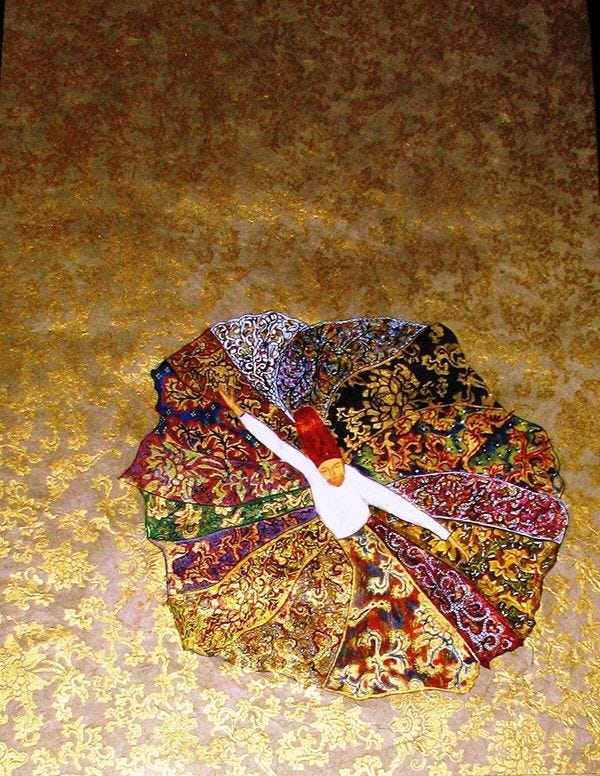A Dervish in an Apple Leaf Heart
Ya Hayyu Ya Qayyum
Above my bed hangs a small painting my sight finds solace in each morning and evening. Suspended between two mirrors, it is small, but in some ways the most noticeable thing in the room. A gold frame hugs it against a white wall, and it’s positioned so the light of both the sunrise and sunset kiss it, illuminating it in a gentle gleam. It’s of a whirling dervish: arms outstretched, robes unfurling in motion, spinning inside what looks like an apple, a leaf, and a heart. Between reflection and reflection he turns, as if caught in an infinite gallery of devotion, his dance multiplied endlessly in glass. I do not know the artist whose heart and hands crafted it, nor their intention; it was a gift my father brought from Konya, a city sanctuary I ache for especially these days. Perhaps that’s why it lingers with me. Its meaning, untethered from certainty, becomes a quiet mystery my curiosity refuses to abandon.
Is he in an apple? It sounds almost absurd, the most fragile of interpretations, yet I can’t let the idea go. The apple — symbol of Eden, of the first temptation, the fruit that tore open the distance between heaven and earth. Sacred because it belonged once to paradise; profane because it became the vessel of our fall. In that way, he exists in a liminal space between the holy and the human. To place a dervish there is to imagine redemption spiraling within sin, a dance that turns transgression into transcendence. The apple becomes not a mark of disobedience but the site of remembrance, where surrender restores what desire once severed. Perhaps the artist meant to depict this; that to live is to whirl endlessly between the sacred and the fallen, until devotion engulfs one in a light so bright that all he sees is the glory of the garden, liberated from the constraints it hides.
Or is he in a leaf? A reflection of the earth we call home — green, grounded, ever turning toward light. He is the most connected to it after all; his spin, too, is a return to harmony with all that breathes. He too is grounded, turning as leaves do in the wind: helpless yet graceful, submissive yet alive, each motion a surrender to the rhythm of God. In his whirling there is no resistance, only release — an echo of creation itself, revolving in quiet praise.
And if it is a heart… whose? His own? Or perhaps ours, the collective heart of humanity? Maybe he lives inside us all, spinning in the hidden chambers of our being. Beneath the hum of blood and breath, there he is — twirling on, pure and persistent, untouched by the corrosion of time. His dance becomes the pulse of faith itself: it is not the beating of an organ that keeps him alive, but the remembrance of the Divine who created it.
Every night I look at it again. The dervish in his apple-leaf-heart — an emblem of balance, of beauty born between loss and love, between Eden and Earth. I think of how I wish I were him, liberated in the whim of a whirl, the only sound around me the hum of my beating heart, quietly calling out Ya Hayyu Ya Qayyum. Then I remind myself that even when the heart feels fractured or faith feels faint, there is still a dervish spinning somewhere within us. His motion is quiet but constant, heard by those who listen closely enough. I look at him again, and remember that faith, too, is a kind of eternal spinning. Perhaps we may stumble from time to time, but as we spin and spin, slowly, we lean into the light.









Lovely like you 🤍
There are constant reminders of beauty around us, to pause and evaluate what’s infront of us is a direct reminder of the presence we currently possess. I enjoy this insight in your moment of time !